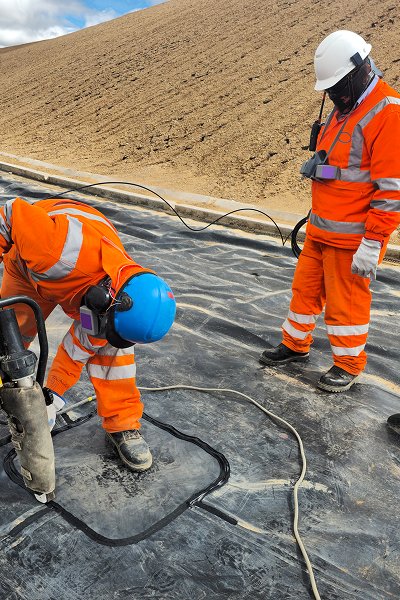Pond liner
Pond liner is a membrane material with excellent waterproof and anti-seepage performance, which is laid on the bottom and side walls of the pond to form a complete waterproof layer. It effectively isolates the contact between the water body and the soil, and prevents water resource waste or pollution caused by foundation penetration.


Anti-seepage function:
prevent water leakage
Isolate water from contact with soil and block the seepage channel;
Reduce water penetration rate and significantly reduce water loss;
Improve water storage efficiency and maintain pond water level stability;
For organic matter or aquaculture water, it can prevent harmful substances from penetrating downward.
Soil protection function:
prevent erosion and collapse of the bottom foundation
Avoid long-term water flow from scouring the bottom of the pool;
Form a stable protective barrier in sandy or loose foundations;
Prevent water pressure scouring from causing soil collapse, landslides and other risks.
Water quality protection function:
Pond lining protects water bodies from external environmental influences through isolation.
Prevent surface pollutants (such as fertilizers and pesticides) from seeping into water bodies;
Prevent aquaculture wastewater in ponds or water bodies containing nitrogen and phosphorus from seeping out and polluting groundwater;
Used in conjunction with monitoring systems in environmental protection projects to effectively track water safety.
Adapt to various extreme climate and soil conditions;
High-strength membrane materials can withstand extreme temperature differences (-60°C ~ +60°C);
Can be used normally in special environments such as saline-alkali land, soft soil, sandy land, etc.;
Strong resistance to UV rays and chemical corrosion.
Agricultural field
Farmland irrigation reservoir
Used to collect rainwater or river water to achieve efficient water storage and seasonal irrigation;
Ensure that the water source does not leak, improve irrigation efficiency, and save costs.
Rice fields, agricultural storage tanks
Control water levels and stabilize the rice growth environment;
Prevent agricultural pollutants from seeping into groundwater.

Aquaculture
Fish ponds, shrimp ponds, crab ponds and other aquaculture water bodies
Prevent leakage from the bottom of the pond and maintain a stable water level;
Isolate harmful substances in the soil and improve the aquaculture environment;
Control the sewage system to avoid the spread of diseases.
Hatchery ponds, ecological aquaculture systems
Provide clean and controllable basic conditions for aquaculture;
Easy to clean, replace and manage.

Landscape and garden engineering
Artificial lakes, landscape pools
Such as urban parks, commercial areas, waterscapes;
Equal emphasis on beauty and practicality, to prevent water from seeping out;
Can be used in combination with green roof systems.
Vertical greening, bottom of water fountains
Prevent water flow from damaging building structures;
Ensure long-term and stable operation of landscape functions.

How to Choose High Quality Pond Liner?
Pay attention to material performance indicators
Impermeability coefficient
Permeability coefficient is less than 10⁻¹³ cm/s;
Preferably use double-glazed or embossed HDPE film to improve density and fit.
Tensile strength and elongation at break
High tensile strength, can withstand slight deformation of the foundation;
Strong ductility, not easy to break during construction.
UV and aging resistance
With UV stabilizer;
Resistant to sunlight, not easy to powder or crack.
Corrosion resistance
Especially in sewage pools and acid-base environments, chemically resistant materials such as HDPE or EPDM must be used.
Thickness
Common specifications are 0.5mm–2.0mm;
The higher the thickness, the stronger the impermeability and durability, and the higher the price.
Priority will be given to products with national or international certifications
ISO9001, ISO14001 quality and environmental management systems;
CE certification, GB standards (such as GB/T 17643);
Third-party test reports or engineering cases may be required.
Brands that provide construction services or technical support
Regular manufacturers generally provide technical guidance and welding services;
There are a wealth of actual engineering cases;
Provide product certificates and factory quality inspection forms.
Choosing high-quality pond liners is not only about material procurement, but also a key guarantee for the quality of the entire pond project. Reasonable material selection, strict quality control, and attention to brand and service support can ensure the long-term stable operation, safety, environmental protection, and economic efficiency of the pond.


